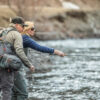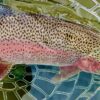Synopsis
September is a magical time to be fly fishing our local rivers – made even more enjoyable with cool mornings and warm afternoons. The weather has stabilized over the past week and looks to be very comfortable for the foreseeable future (except for a couple of midweek thunderstorms). The Big Wood will be heating up as the Red Quill begins to make its annual appearance and Silver Creek is fishing nicely with strong Baetis and Callibaetis in the midday and afternoons. The Big Lost is fishing well with Tricos and Baetis and the yearly run of Kokanees above the reservoir is in full swing. The alpine fishing will begin to subside with cool night time temperatures and the South Fork of the Boise is flowing at usual fall levels with some walk and wade opportunities. All in all, autumn fishing is picking up and as the leaves begin to turn yellow, fishing will enter its most beautiful season.
Big Wood River
The Big Wood (181cfs) is fishing well as the Baetis continue to be present from the later morning until the late afternoon. On average, the night time temperatures will be in the mid to high thirties which means that it is not necessary to begin fishing at the break of dawn but rather wait to fish until the warmth of the day. The Red Quill (Hecuba) has begun to appear on the Big Wood and is one of the most exciting insects of the entire year to throw. These Green Drake sized mayflies become a serious focus of rainbows as September presses on and are most abundant during the midday and afternoon hours. Patterns similar in appearance and size to the Green Drake will serve the angler well. Grasshoppers are still numerous and should be considered in the afternoons in addition to a mayfly nymph or zebra midge dropper. Rusty Spinners will be an excellent selection as well as October caddis which will also be an important pattern as one navigates the river system, so come well equipped with larger elk hair caddis patterns.
Silver Creek
The Creek is fishing very well, especially during the heat of the day. Baetis can be present in large numbers beginning around 9:30 or 10:00a and continue past noon. Don’t be surprised to find Tricos, sometimes in quite good numbers, spinning in the morning hours. The Callibaetis are the prime focus at the moment and are gathering in large numbers both on the still and moving water. If one pays close attention, it will be clear that there is not only a spinner fall of these speckle-winged mayflies but simultaneously an emergence. Cripple patterns along with duns are excellent choices until the spinners start drifting downstream. Mahogany Duns will appear anytime and are a treat to fish as the rainbows and browns rise to gulp this tasty insect. Expect to see these burgundy bugs during the middle of the day. Terrestrials, including ants, beetles and hoppers – especially on windy days – are always good options if the mayfly activity is less than intense.
Big Lost River
The Lost (309cfs) is flowing at a very fishable level. The September Trico fall is occurring with some periods of intense morning action. As is true with the Big Wood, the Big lost will also offer some good Baetis fishing. Nymphing does tend to be the most productive technique both above and below the reservoir. If the top water action is minimal, try prince nymphs and zebra midges. Egg patterns and San Juan worms may find some response as the Kokanee continue their spawning run. It is still worth skating Craneflies even if they are not present on the water as fish are accustomed to them and might still take a swipe.
Upper Big Lost / Copper Basin
The alpine fishing generally begins to wane in the beginning of September, as the nightly low temperatures approach freezing. As the water temperatures drop, especially higher up in the system, the insect activity dwindles, lessening the available food sources and forcing the fish to move downstream. Therefore, it would be wise to try fishing lower in the system whether in the East Fork or the mainstream proper. Cold morning temperatures will mean a later start to the daily activity so plan accordingly. Attractor patterns such as flying ants, beetles, trudes and wolfs in addition to elk hair caddis and Parachute Adams will bring fish to the surface. When all else fails, nymphs dredged through the remaining deep pockets should produce nicely.
South Fork of the Boise
The South Fork of the Boise is flowing at its September norm of 601cfs. The upper section of the river below Anderson reservoir is floatable but below Indian Rock the river is too dangerous to drift. Try to walk and wade this section of the river using a combination of Pink Alberts, Parachute Adams, caddis, Baetis, hoppers and a variety of nymphs. Streamers can be effective, especially if fished in a quartering down fashion in the direction of the banks.
Salmon River
The Salmon continues to fish very well below Stanley. Attractor patterns such as large caddis, stimulators and terrestrials, when coupled with droppers such as King Prince nymphs, caddis pupae and zebra midges are producing very well. The Chinook Salmon run is essentially over with a few stragglers remaining on their Redds, but most of these beautiful giants have died and been absorbed back into the ecosystem. Is it too early to start talking about spring steelheading?



